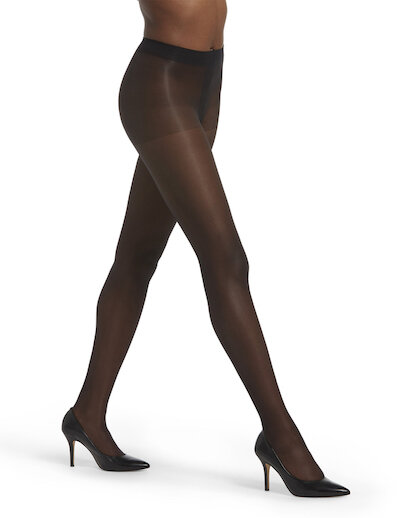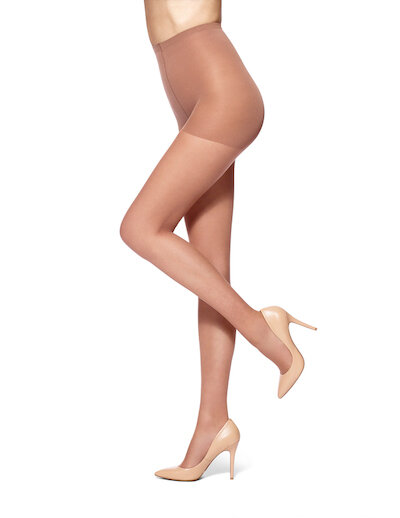Back in the day, achieving one’s ideal figure was quite a challenge. To begin with, there weren’t many garments to choose from, other than corsets and girdles. To make matters worse, these garments were riddles with controversial design choices. Said garments were made with metal, and long-term use would lead to deformities in bone structure, among other issues.

Modern type of hosiery
These days, many fashion brands now offer all sorts of shapewear for women, from waist cinchers to control top sheer hosiery. Fortunately, today’s shapewear can now help women accentuate their body shapes without the problems that once plagued these garments. Indeed, modern fabrics and fashion innovations would produce an entire industry of shapewear that allowed women to adjust their figures in almost any way they wanted.
If you’re interested in learning more about these oft-misunderstood garments, read on to learn more about how the shapewear we know today came to be.
The origins and evolution of shapewear
Even before the first corset, body-shaping garments are perhaps among the oldest types of clothing in the history of fashion.
The idea for body-shaping
The concept of shapewear can be traced back to ancient Greece around 1600 BCE during which women wrapped special belts (often made of metal or leather) to constrict the stomach. Around the same time, women in Mesopotamia were wearing the first girdles in devotion to some of their female gods depicted wearing the garment.
At the time, these ancient pieces were worn by women to forcibly reduce their waists and emphasize more of their chests. In some of these primaeval cultures, this type of figure was supposed to symbolize virginity and fertility.
Shapewear of the middle ages
In the medieval era, both men and women frequently wore dress-like pieces called smocks or chemises. The difference was that women were also incorporating bodices to tighten the waist and bolden the chest, similar to how they used ancient girdles for the same purpose. It wasn’t until the 1400s that the French introduced the cotte, a full-body dress that tightened the waist. Eventually, the cotte was reduced to just the waist section, becoming the first iteration of the corset.
The corset remained a staple during the Victorian Era in which the hourglass figure became the ideal. However, corsets were made with hard materials like iron. Thus, the corsets of old were quite dangerous to wear.
The beginning of modern shapewear
Come the 1900s, shapewear began to tackle more than just the waist. The modern girdle was invented for smoother curves around the hips, reaching as far down as the thighs, and the bra replaced the corset. Moving forward, the World Wars reserved more fabrics and metals for the military, which paved the way for nylon and other synthetic fabrics and, eventually, the invention of pantyhose.
These inventions led to the industry diversifying and innovating its collection of shaping garments, creating products for slimming, emphasizing, or shaping any combination of body parts and sections. It was propelled by a paradigm shift towards female empowerment, allowing women to decide for themselves what their ideal figures should look like.
Problems with shapewear of the past
Shapewear would not have had to change so much if they did not have so many glaring design problems throughout history. There were particular features about these shaping accessories that had to be changed as they evolved.
Hard and uncomfortable materials
For the longest time, shapewear were made with hard materials such as iron and steel. At some point in time, corsets were even lined with whalebone for more rigidity. As such, wearing these kinds of shapewear meant forcing one’s body into it so as to make one’s waist take the corset’s shape. In hindsight, it’s quite obvious that these materials were never suitable for making clothes at all.
Dangerous constriction levels
For centuries, the approach of shapewear was to go slimmer with each iteration. Women themselves were trying to minimize their waists as much as possible. However, the impossibly small sizes and the use of hard materials resulted in detrimental levels of constriction to the body.
To be specific, the rigid structures of shapewear from the past led to unhealthy deformities in women’s bone structures. Aside from broken ribs, individuals who wore these uncomfortable corsets also suffered from lung restriction and constant asphyxiation. These constrictions around the waist also meant that internal organs—especially the digestive system—were dangerously compressed, causing all manner of illnesses.
Lack of variety
From the first girdle to the corsets of the 1900s, shapewear was mostly designed to address only the minimization of the waist and not much else. Thus, the corset and girdle posed great limitations not only to how women hoped to achieve the hourglass figure, but also on what parts of their bodies they could shape.
How shapewear has changed (for the better)
Synthetic fabrics have allowed for the creation of comfortable shapewear with the same body-shaping features, all without the use of metal components. The invention of nylon opened up a world of clothing materials that could act as a substitute for the hard metals of the past. Additionally, nylon has also been used as the basis for new and revolutionary kinds of shaping garments. Shapewear made with these fabrics also felt a lot more breathable against the skin and allowed for better freedom of movement.
What was perhaps one of the most important milestones in shapewear’s history was the eventual creation of lycra or spandex. The elastic properties achieved by the fabric allowed shapewear to tighten certain areas of the body without dangerous levels of constriction. As such, shapewear made with lycra no longer squeeze the organs so much, nor do they hinder breathing to the point of discomfort.
Compression levels and sizes
Shapewear today is no longer one-size-fits-all, as they’re now available in different sizes to complement any type of body. This shows that today’s fashion industry has grown more inclusive of all people rather than mostly favoring those with figures that are already thin, to begin with.
Furthermore, there are now options for adjusting the intensity of body-shaping thanks to the creation of shapewear with different compression levels. Aside from providing control over how drastic the contouring will be, having shaping garments in a variety of compression levels also makes it much easier for beginners to get started. Newbies can try shapewear with less constriction at first, then move on to higher compression levels as they get used to wearing these types of garments.
The ability to shape any part of the body
Constricting the waist is no longer the only way to emphasize the chest or to enhance the butt like in the past. Now, there are dozens of shaping garments and even hybrids that combine different types of shapewear into one seamless piece.

Nowadays, shapewear can contour the torso all the way down to the thighs, and there are even bodysuits that help anyone fit into any cocktail dress. Some special garments also shape the arms or add volume to the butt. Shapewear can also be integrated into other common undergarments such as control-top hosiery.
How today’s shapewear can benefit the modern woman
In contrast to olden body-shapers, women can take advantage of modern shaping garments to take their fashion game to the next level all without sacrificing their health and well-being. What many people may not know is that using shapewear can lead to some lesser-known benefits, such as the following:
Enables women to have more freedom with their wardrobe
Using shapewear can widen the range of outfits that a person can wear. New clothes that are usually too tight can now fit a little more easily once more. Meanwhile, older fashion pieces can look new when worn with an improved silhouette.
Provides additional back and abdominal support
Now that these shaping garments no longer harm the body, they can actually offer some health benefits. For one, the added back support can sustain a person’s posture while relieving long-term strain throughout the day. In some cases, shapewear can even support the abdominal muscles. However, one can only reap these benefits if they get shapewear in the right size.
Helps women look and feel good (in a way that works for them)
Perhaps the best part about shapewear is that it can help anyone feel more confident in themselves. For one, shapewear helps people maintain good posture by keeping their back straight. This, in turn, can contribute to one’s feelings of self-confidence. It can also feel elating to be able to wear old clothes that used to no longer fit one’s body, and it can be empowering for a person to achieve their ideal silhouette once they’ve found shapewear that works for them.
Shapewear has indeed come a long way from the troubles that they used to impose upon women. Now that modern fashion companies have come up with ways to eliminate the issues that shaping garments had in the past, women now have more power and control over shapewear. Truly, they can now make these items work for them rather than forcing their bodies to conform to the rigid accessories of old. As long as people choose shaping garments in the right size and fit, they shouldn’t have to worry about going through the discomforts of using the shapewear of the past.
(Cover photo from: Ike Louie Natividad via Pexels)
Monica Mendoza is a writer by profession who has written extensively on the subjects of Fashion, Finance, and Technology. Her work has been published across many respected, and well-known websites and publications. In her free time, she enjoys hiking, surfing, and traveling across the contiguous US states. She dreams of retiring in Montpellier in France someday.
Comments, questions or feedback? Email us at [email protected].








